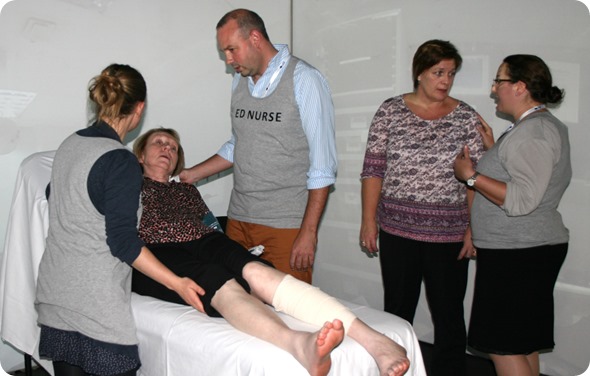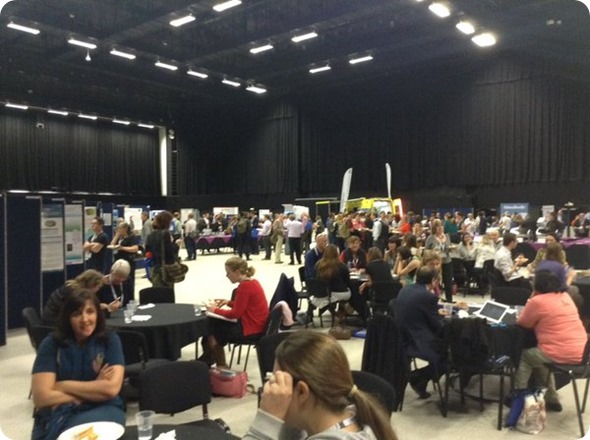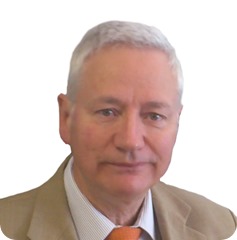Can you give me a brief overview of the currently used simulated practice techniques in healthcare teaching? Where are they used and how widespread are they?
There's around 95 to 100 simulation centers across the NHS in secondary care. These centers are used for a whole variety of training, practicing of skills and recreating incidents so that staff can prevent them recurring.

Simulation role play with the SimHeroes competition, ASPiH 2015.
In undergraduate training, there are also many centers using simulation for training nurses and doctors in the basic skills they need to develop through their training in universities, then in practice, as a continual development of skills.
The general field of simulation based education is endemic across the NHS. Virtually every institution will do some simulated practice, but what they do and the extent to which they buy into it is extremely variable.
What techniques and procedures can be simulated? What is used for the simulations? How is the teaching administered?
The core definition of simulation is the imitation of one act by another. It starts from simple role-playing, by simple, that's not to underestimate the value of practicing verbal communication one-on-one, or one with the group.
.jpg)
Simulation using an actor to replicate emergency healthcare after severe burns to a patient, ASPiH 2015.
The most realistic simulator we have is a human being. There's an increasingly expanding community of simulated patients. These can be real patients who talk about how their condition affects their lives, for example, medical students may interview diabetics to learn how their condition changes their day to day lives from the small to the big things.
Increasingly now, there is a fraternity of specially trained simulated patients who are trained either as actors or just people who mimic situations or conditions allowing professionals to interact with them as if they were patients. That's the most realistic simulation you can achieve.
Technological simulation ranges from simple plastic arms through to very complex, computer-based mannequins that mimic a wide variety of complex physiological parameters. Really anything that happens to a patient can, in theory, be simulated.
.jpg)
Simulating drawing blood work from plastic arm with working blood flow, ASPiH 2015.
Can you briefly describe what ASPiH is as and organization and what they’re doing to increase the prevalence of simulation in medical teaching in the medical industry?
ASPiH, the Association for Simulated Practice in Healthcare, is a not-for-profit organization connecting all those involved in healthcare simulation. A limited company in structure terms, we have over 600 members, all of whom are practicing or practitioners of simulated healthcare in one form or another.
.jpg)
We try to pass good practice from arena to another, and to understand issues that are faced by those practitioners, and provide or develop solutions with our partners.
We interact with an increasingly wide audience, including lobbying commissioners and decision-makers in the health service to fund more simulated practice, to make them aware of the cost-benefits and to outline the benefits to patient safety that simulation undoubtedly offers.
Right now, many decision makers don't see the significant patient benefits of doing more and more simulated practice. In some cases, the purchase of simulation resources is regarded as a cost, not an investment. That's a big awareness challenge for us that we are focusing on in the near future.
Along with lobbying to increase funding for simulation, what is being done by ASPiH to make simulated medical training more accessible to both students and patients?
We are very connected with our industry partners, and understanding and informing their technological development direction is a key part of our role. Through our web site and expanding exhibition at annual conference, we keep the community up to date with future platform developments.
One of our major initiatives this year is the development of a draft set of guidelines and associated standards of practice. Practitioners need a framework, and our guidance will help people work more consistently and increase its potential impact, which is a key aim for the Association.
One of our increasing networks is within the patients themselves. Getting patients to help simulated practice be more real an engaging is a real priority, particularly at this year's ASPiH conference. This event, which this year had over 500 people attend over two and a half days, is the major multi-disciplinary simulation conference in the UK, and increasingly attracts colleagues from around the world.

Occurring every November, the program offers delegates a chance to exchange ideas and innovations in a collaborative, collegiate manner.
How do you think patients perceive simulation in healthcare? How would increased simulation affect the relationship between patients and healthcare professionals?
I think a large majority of the general public would be unaware of the way doctors are trained. If you said to the vast majority of the general public:
"Do you realize that, for example, doctors don't use simulation like pilots do? Every six months, pilots are trained or reassessed in the simulator. There's still a huge number of practitioners who qualify and who’s competence never get tested again?"
I think the general public would be quite shocked at the lack of assessment of performance or quality of delivery. I also think they’d be concerned that using the latest simulation technologies to practice skills, develop team working and improve communications is not compulsory for all healthcare staff at all levels.
Some might think if you turn it around the other way and say, "Well, once doctors are trained primarily on simulators, would that undermine their confidence in whether they're a good practitioner with real patients?" I would say the opposite.
If you're about to go in for surgery and you ask the doctor, "How many times have you done this?" The doctor said, "It's only my second time." I think the vast majority of general public would probably ask for a more experienced practitioner and would prefer that health care professionals practice on some kind of simulator or some kind of non-threatening environment many times before they are cleared to perform dangerous or complex procedures. That certainly isn't the case at the moment.
How would you like to see simulations and simulators used in the training of medical practitioners?
You have to remember that a mistake from a patient’s perspective even a small mistake can be life changing or debilitating. We may not be able to get to the aviation model, where the technology of simulation is so well-developed that pilots can learn and be certified to fly the real thing in the simulator with complete competence. Human beings are too variable, situations are variable, and team members are changing all the time so we cannot use simulation in the same way.
However, we can and should use simulated practice to train skills and ensure basic competencies and avoid, as far as possible, practitioners practicing on patients. There’s a step-wise process where for many procedures, you should not be doing the procedure on a patient until you pass an element of simulated practice. It doesn't mean you're competent but at least you've passed a certain level of skill.
A good example of that is the start-up company called Touch Surgery. They have a free app, you download off iTunes or Android store. It's got upwards, of 30 procedures, which you do on your smartphone. This technology can teach a sequence of events so that when you get into theatre, that piece is in your head. You're less likely to make a procedural error.
It’s integrated learning that builds up a student’s experience rather than throwing them in at the deep end. Learning parts of a certain technique, via an app, e-Learning, or a very basic simulator. You may then go in and watch the patient. You’re maybe even allowed to do non-safety critical parts of the procedure.
The higher-fidelity, more expensive simulator can then be used to develop and enhance more complex skills. This step wise, technology enhanced learning process could save the NHS time, improve competence and make a significant contribution to increasing patient safety. There is obviously a point at which every practitioner has to do the procedure “live”.
Epidural needles are going in as we speak by students who've never done one before on a live patient. I think if the general public knew that that was happening they might ask "How many times have you this? Show me your certificate that you’ve passed some sort of assessment."
There's plenty of junior doctors out there who are in a stressful environment, doing procedures they are not fully confident in performing. What we’re trying to do is raise the awareness of these issues and trying to make simulation a much larger part of more safety-critical procedures.
Where do you see simulated medical teaching in the future? Do you think all medical practitioners will have to pass simulated learning before graduating to patients?
I see simulation as an absolutely core platform for developing skills and assessment of competence. I would assert that practitioners wouldn't be able to perform a whole range of procedures until they’ve demonstrated competence at a whole range of levels of simulation.
We need agreed standards for how best to do deliver simulated practice and more research to demonstrate the financial and safety benefits to government, commissioners and key decision makers.
In the digital age, it is almost impossible to control the way people learn. The only thing you can measure and control is the competence of the individual and the amount of practice they undertake. That's where simulation can add the most value to patient outcomes. It will be one of the gates that people go through before they're allowed to practice. It won't be the only one, but it'll one of the key ones.
What do you think the future holds for ASPiH?
Our plans for the next two years are looking very positive. We’re being asked to create and write practice guidelines and standards, to be the representative of a community which is well-respected and increasingly vital to the healthcare field. If the commissioners and health education policy makers want to understand the implication of a change in training and education related to simulation, they now come to ASPiH. I think that's something we need to build on.
People don't know we exist in the many corners of the NHS. I'd like to get our membership up significantly. I'd like to increase awareness of our aims, values and experience to help all those using simulation in all its forms develop their skills, knowledge and programs. To make the Association more sustainable for the future, we need to increase member value and perhaps partner with other organizations to produce effective training programs.
We are probably the most developed simulation Association outside of the USA. We've been going six years whereas many other countries are only just starting to get a formal body together. We're certainly willing and happy to work with others such as SESAM, the European Association, to get the message out there to a much wider audience both across the UK and internationally.
A recent example of some of the challenges we face came from a meeting with some physiotherapists. They use role-plays with actors and team exercises, but they struggle to get their trust to fund it. The trust just doesn't see the benefit of putting money into that because they think, “it's only physiotherapy”. It's not life-threatening, absolutely, but what they don't see is the benefits to patients in improving outcomes and the consequential cost savings to the NHS of less re-admissions and lower staff turnover.
Where can readers find more information?
They can visit our web site at www.aspih.org.uk and attend our next conference in Bristol on the 15th to 17th November 2016.
About Andy Anderson
Andy is Chief Executive Officer for ASPiH. He also owns and manages a medical education and business management consultancy company. Andy manages the business of the Association including membership, financial and development activities. He is supported by a part-time administration team and the Executive committee.
Andy’s company became the leading distributor of medical simulation systems for the UK and Ireland from 2000 to 2006. The company distributed many of the early VR and mannequin systems. After selling the business in 2006 he was engaged by Portsmouth NHS Trust as the Business Manager for their simulation center. He was also spent a year as UK managing Director for CAE healthcare and brings this wealth of experience in the simulation business to ASPiH.
Andy is also a keen golfer and aviation enthusiast having completed 18 hours of a private pilot license. He is also Chair of Governors at a local state school.